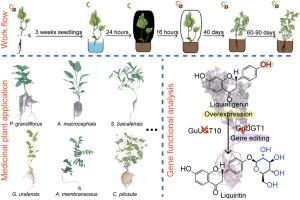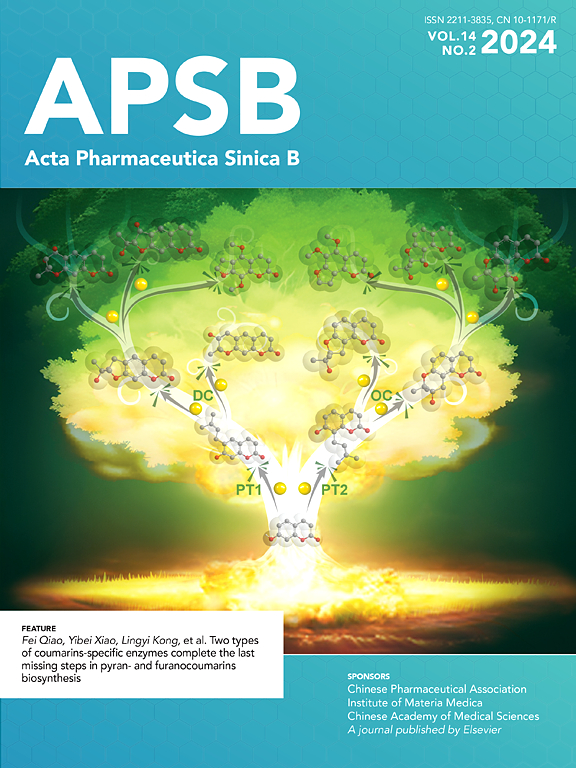A simple widely applicable hairy root transformation method for gene function studies in medicinal plants
IF 14.6
1区 医学
Q1 PHARMACOLOGY & PHARMACY
引用次数: 0
Abstract
Genetic transformation is a fundamental tool in molecular biology research of medicinal plants. Tailoring transgenic technologies to each distinct medicinal plant would necessitate a substantial investment of time and effort. Here, we present a simple hairy root transformation method that does not require sterile conditions, utilizing Agrobacterium rhizogenes strain K599 and the visible RUBY reporter system. Transgenic hairy roots were obtained for six tested medicinal plant species, roots or rhizomes of which have recognized medicinal value, spanning four botanical families and six genera (Platycodon grandiflorus, Atractylodes macrocephala, Scutellaria baicalensis, Codonopsis pilosula, Astragalus membranaceus, and Glycyrrhiza uralensis). Furthermore, two previously identified Glycyrrhiza uralensis UGTs that convert liquiritigenin into liquiritin in heterologous systems were studied in planta using the method. Our results indicate that overexpression of GuUGT1 but not GuUGT10 and Cas9-mediated knockout of GuUGT1 profoundly influenced the accumulation of liquiritin and isoliquiritin in licorice roots. Therefore, the method described here represents a simple, rapid and widely applicable hairy root transformation method that enables fast gene functional study in medicinal plants.

一种简单、广泛适用于药用植物基因功能研究的毛状根转化方法
遗传转化是药用植物分子生物学研究的基本工具。为每种不同的药用植物量身定制转基因技术需要投入大量的时间和精力。在这里,我们提出了一种简单的毛状根转化方法,不需要无菌条件,利用根农杆菌菌株K599和可见RUBY报告系统。6种药用植物(桔梗、苍术、黄芩、党参、黄芪、乌拉尔甘草)的根或根茎具有公认的药用价值,获得了转基因毛状根。此外,利用该方法在植物中研究了两个先前鉴定的在异源系统中将甘草素转化为甘草素的glycyrhiza uralensis ugt。我们的研究结果表明,GuUGT1的过表达而不是GuUGT10和cas9介导的GuUGT1的敲除深刻影响甘草根中甘草素和异甘草素的积累。因此,本文所描述的方法代表了一种简单、快速、广泛适用的毛状根转化方法,可以快速研究药用植物的基因功能。
本文章由计算机程序翻译,如有差异,请以英文原文为准。
求助全文
约1分钟内获得全文
求助全文
来源期刊

Acta Pharmaceutica Sinica. B
Pharmacology, Toxicology and Pharmaceutics-General Pharmacology, Toxicology and Pharmaceutics
CiteScore
22.40
自引率
5.50%
发文量
1051
审稿时长
19 weeks
期刊介绍:
The Journal of the Institute of Materia Medica, Chinese Academy of Medical Sciences, and the Chinese Pharmaceutical Association oversees the peer review process for Acta Pharmaceutica Sinica. B (APSB).
Published monthly in English, APSB is dedicated to disseminating significant original research articles, rapid communications, and high-quality reviews that highlight recent advances across various pharmaceutical sciences domains. These encompass pharmacology, pharmaceutics, medicinal chemistry, natural products, pharmacognosy, pharmaceutical analysis, and pharmacokinetics.
A part of the Acta Pharmaceutica Sinica series, established in 1953 and indexed in prominent databases like Chemical Abstracts, Index Medicus, SciFinder Scholar, Biological Abstracts, International Pharmaceutical Abstracts, Cambridge Scientific Abstracts, and Current Bibliography on Science and Technology, APSB is sponsored by the Institute of Materia Medica, Chinese Academy of Medical Sciences, and the Chinese Pharmaceutical Association. Its production and hosting are facilitated by Elsevier B.V. This collaborative effort ensures APSB's commitment to delivering valuable contributions to the pharmaceutical sciences community.
 求助内容:
求助内容: 应助结果提醒方式:
应助结果提醒方式:


